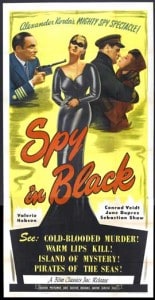Women and children first…to die…in U-Boat attack! Suicide submarine crews ravage the high seas…in history’s most ruthless slaughter of innocents! – original release tagline
Some films come around at just the right time. Others not so much. The premiere of The Spy in Black (released as U-Boat 29 in the States) probably falls into the latter, coming in August of 1939; literally weeks prior to the start of hostilities in World War Two.
Note that this post is a part of the exciting Snoopathon hosted by Movies Silently. Check out all the posts by clicking on the ad below- and also the site itself, which is a great resource for those into the silents.
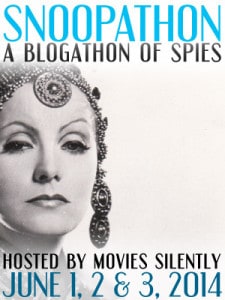
Starring the now often overlooked Conrad Veidt, Spy speaks to a different war; the War to End All Wars as they used to call it. Though as now that war is countless wars ago, the term has fallen into a bit of disuse.
Let’s look again at that tagline at the start of this writing and what impression it gives the reader about the film. I don’t know about you, but it tends to give the impression of something along the lines of Das Boot– meaning a core submarine movie. It isn’t. Rather, The Spy in Black is a spy thriller which happens to have a submarine involved.
Unlike similar films (especially British ones) from the period, there only a slight anti-German bias baked in. This bias grew as anti-Hitler sentiment grew in advance of what most saw as another war with “the Huns.” This can be seen in most pictures that the country produced, but Michael Powell and Emeric Pressburger (in their first collaboration) keep any outward bias for the most part fairly subdued.
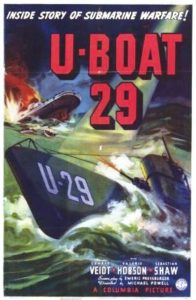 Veidt is Captain Hardt, a veteran U-Boat commander during World War One. As the movie opens he is completing a patrol with his crew but is hoping for a fine meal and some relaxation, he is confronted by shortages and rationing. He’s then given a mission to sail to the Orkneys and meet up with a German spy there in hopes of sinking a good part (perhaps all) of the British fleet. Suspend reality for a moment…one submarine sinking the entire British fleet?
Veidt is Captain Hardt, a veteran U-Boat commander during World War One. As the movie opens he is completing a patrol with his crew but is hoping for a fine meal and some relaxation, he is confronted by shortages and rationing. He’s then given a mission to sail to the Orkneys and meet up with a German spy there in hopes of sinking a good part (perhaps all) of the British fleet. Suspend reality for a moment…one submarine sinking the entire British fleet?
The plot sounds fairly pedestrian, but there are some very exciting and intriguing twists along the way- especially in the latter reels- which we won’t divulge here. So know there is more to this than we are letting on. You won’t be disappointed.
From my perspective, there are three things which make this movie work and work well. First is the production. Much of the shoot was done on location in the Orkneys and it shows. And though the special effects are not spectacular by today’s standards, they still for the most part hold up. I was pleased to see that the models used betray themselves very rarely here. Even the splashes, which are usually the telltale sign of modelling betray very little.
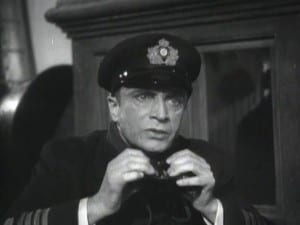 Also the score by Miklos Rozsa bears mentioning here. It is a bit brassy but appropriately subdued and further enhances the already pervasive atmosphere which builds in the film. There are no Ben-Huresque fanfares and there are times when perhaps a bit more music would help, but overall the results are very effective.
Also the score by Miklos Rozsa bears mentioning here. It is a bit brassy but appropriately subdued and further enhances the already pervasive atmosphere which builds in the film. There are no Ben-Huresque fanfares and there are times when perhaps a bit more music would help, but overall the results are very effective.
As I mentioned earlier, this is the first collaboration between Powell and Pressburger, though isn’t quite as refined as their productions would become once they solidified the partnership as The Archers. Importantly here, they resist the urge to turn the film into a purely propaganda piece as they did for their later 1941 effort 49th Parallel. Granted, by 1941 the presumed war was for real, but most filmmakers by 1939 would have taken a different bent with the Germans. This angle was taken in the marketing of the picture, but the picture itself is pointedly neutral and avoids characterizing the Germans as heartless SOBs.
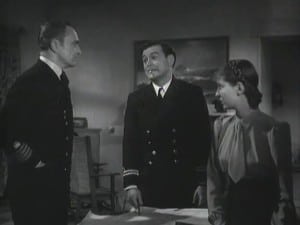 Second is the characterizations. Most films of the time, especially British productions, were rather flat and filled with stereotypical characters. Rarely were they fleshed out and at times seemed to be mere cutouts of reality. Here all the characters, even the minor ones, are quite well rounded out and are very engaging with the audience. This really lends to a grippingly real portrayal and helps the viewer immerse themselves further into the proceedings.
Second is the characterizations. Most films of the time, especially British productions, were rather flat and filled with stereotypical characters. Rarely were they fleshed out and at times seemed to be mere cutouts of reality. Here all the characters, even the minor ones, are quite well rounded out and are very engaging with the audience. This really lends to a grippingly real portrayal and helps the viewer immerse themselves further into the proceedings.
Third and perhaps most importantly is Conrad Veidt himself. Here we will spend a bit more time, as he is the glue which holds this piece together. His performance and character also carry more heft perhaps than most and it is here that one truly sees the care that was taken in crafting Captain Hardt.
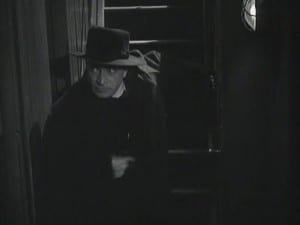 Hardt could have been presented as a cruel, harsh, and evil German. He (Veidt) probably would have been okay with this as, knowing because of his Germanic heritage that we would be typecast, was always ready and willing to play a Nazi. Even though he was an adamant opponent to Nazism (he donated heavily to the British war effort) he had only one stipulation. That was that whenever he played a Nazi, that Nazi had to be a villain. No softy Nazis for Mr. Veidt. In any case, there was no Nazism during World War One, so perhaps a bit of a tangential relationship.
Hardt could have been presented as a cruel, harsh, and evil German. He (Veidt) probably would have been okay with this as, knowing because of his Germanic heritage that we would be typecast, was always ready and willing to play a Nazi. Even though he was an adamant opponent to Nazism (he donated heavily to the British war effort) he had only one stipulation. That was that whenever he played a Nazi, that Nazi had to be a villain. No softy Nazis for Mr. Veidt. In any case, there was no Nazism during World War One, so perhaps a bit of a tangential relationship.
But back to The Spy in Black; Hardt is almost endearing for the first half of the film. With the entire film told from his viewpoint, we get a tremendously deep feel for him. Veidt’s Captain Hardt isn’t on a mad campaign to kill the English. Actually he doesn’t really care that much at all for his mission- it is merely a job. Although not in agreement with his orders, his will is to do his duty and carry them out. His only wish is to be home, enjoying a good beer and something other than fish for dinner.
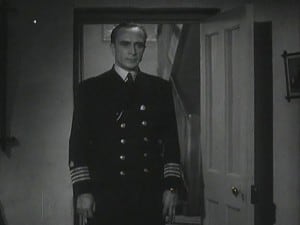 There is the perception that, though enemies of the British in the First World War, the Germans weren’t quite as dastardly as they became during the Second World War. My takeaway is that in The Spy in Black they are more like disagreeable neighbors with whom Britain shares a fence; the two nations aren’t that different at their core and there is a common respect there. Wishful thinking, perhaps.
There is the perception that, though enemies of the British in the First World War, the Germans weren’t quite as dastardly as they became during the Second World War. My takeaway is that in The Spy in Black they are more like disagreeable neighbors with whom Britain shares a fence; the two nations aren’t that different at their core and there is a common respect there. Wishful thinking, perhaps.
This is especially true in a few key areas of the film, with at least the two I cite occuring in the opening reels. The dignity with which Captain Hardt treats his uniform (and his service), even to the point of refusing to take it off, shows a class that most Britishers of the day would likely identify with. (Though again it could also go to the question of a potential capture. If captured in uniform he would be treated as a prisoner of war and imprisoned. If in civilian clothes he would likely be shot as a spy.)
The second and more impressive is the scorn with which he regards Ashington, a traitorous officer in the Royal Navy. Tying back to his mantra of complying with orders he cannot fathom one turning traitor. The derision in Veidt’s stare as he contemplates Ashington is palpable.
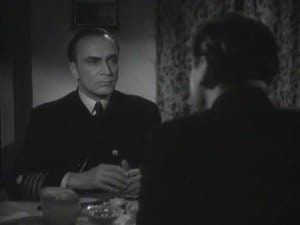 Veidt is stern here, though from my perspective he is always stern. The way he meets some of the more ironic twists that the story take reflects his demeanor. Even the emotion he does show, mainly in some of his interplay with schoolteacher/spy Valerie Hobson, is very restrained. It all drives a wonderful atmosphere which isn’t often replicated.
Veidt is stern here, though from my perspective he is always stern. The way he meets some of the more ironic twists that the story take reflects his demeanor. Even the emotion he does show, mainly in some of his interplay with schoolteacher/spy Valerie Hobson, is very restrained. It all drives a wonderful atmosphere which isn’t often replicated.
And here is the punch line. The Spy in Black was made as a ‘quota quickie.’ This was the then law in Britain that theaters show a certain percentage of films made by British studios, or in this case the British unit of an American studio (Columbia here).
This isn’t any mere quota filler. Given its tight running time it won’t take much of your time and it will be time well spent. Check it out.
